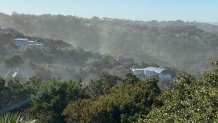It's that time of year again: Watery eyes, runny nose, and lots and lots of sneezing. Allergy sufferers know "Cedar Fever" well. The culprit? Cedar pollen.
Specifically, we're talking about Mountain Cedar, which is also known as Juniper. Mountain cedar season runs from late December to February, so, unfortunately, it's just getting started. As the pollen becomes airborne down in the Texas Hill Country, it blows up this way whenever we get a south or southwest wind.
As you can see in the video above, the pollen cloud can get quite thick, blanketing everything in its path with a coating of yellow dust.
Get DFW local news, weather forecasts and entertainment stories to your inbox. Sign up for NBC DFW newsletters.
A map published by pollenlibrary.com shows where these Juniper trees are most prevalent. Clearly, the highest concentration is to the southwest of DFW.
If you deal with "Cedar Fever," here are a few things that will help alleviate your suffering:
- A strong north wind (to push the pollen back south)
- Rain (to help settle the airborne pollen)
- Staying indoors and changing your air filters.


